I'm putting the campaign on hold while I work on the AI combat code, so this post brings the campaign up that point.5 January 2054The Russian Federation completes the gravitational survey of Sol. Revnostnyy heads for Barnard’s Star, under orders to escort the geological survey ship Viktor Leonov back into Sol and then to survey the system. As the Bernard’s Star jump point is on the edge of the Sol system, it makes sense to carry out a survey while Revnostnyy is visiting the system anyway. The other Russian gravitational survey ship, Doblestnyy, heads for Lalande via a refuelling stop at Earth. Meanwhile, the European Union is still surveying Sol and detects the jump point to Bernard’s Star.
13 January 2054After another failed attempt, the Russia Federation recover 4.8m litres of fuel on Mars. Russian now has ten million litres of fuel on the surface, although no way to load the fuel at the moment.
28 January 2054The People’s Republic of China launches its third and fourth gravitational survey ships. This gives the Chinese a significant exploration advantage over the other powers. Russia and India each have two ships in service, while the Colonial Alliance, the European Union and Brazil only have one operational gravitational survey ship. To push home their advantage, the Chinese lay down the fifth and sixth units of the class. The two new ships are ordered to begin a survey of V1216 Sagittarii.
4 February 2054Russia recovers another 5.4m litres of fuel. China trains its first construction formations and transport them to Mars. The European Union launches its first Jaguar class Jump Freighter, joining those nations who can mount interstellar colony expeditions.
Jaguar class Jump Freighter 73,850 tons 369 Crew 1,130.1 BP TCS 1,477 TH 1,900 EM 0
1286 km/s JR 2-25(C) Armour 1-156 Shields 0-0 HTK 127 Sensors 5/5/0/0 DCR 1 PPV 0
MSP 9 Max Repair 191.3 MSP
Cargo 25,000 Cargo Shuttle Multiplier 4
Capitaine de frégate Control Rating 1 BRG
Intended Deployment Time: 3 months
JC75K Commercial Jump Drive Max Ship Size 75000 tons Distance 25k km Squadron Size 2
Commercial Nuclear Pulse Engine (19) Power 1900 Fuel Use 10.06% Signature 100 Explosion 5%
Fuel Capacity 1,000,000 Litres Range 24.2 billion km (217 days at full power)
Navigation Sensor (1) GPS 1300 Range 20.2m km Resolution 130
EM Sensor (1) Sensitivity 5 Detect Sig Strength 1000: 17.7m km
Thermal Sensor (1) Sensitivity 5 Detect Sig Strength 1000: 17.7m km
14 February 2054India completes a gravitational survey of the Sol system. Russia recovers 6000 tons of Corundium on Mars. China launches its first Type 008 class Jump Tender.
Type 008 class Jump Tender 34,700 tons 242 Crew 676.5 BP TCS 694 TH 1,280 EM 0
1844 km/s JR 2-25(C) Armour 1-94 Shields 0-0 HTK 67 Sensors 5/5/0/0 DCR 1 PPV 0
MSP 12 Max Repair 142.8 MSP
Zhong Xiao Control Rating 1 BRG
Intended Deployment Time: 3 months
JC51K Commercial Jump Drive Max Ship Size 51000 tons Distance 25k km Squadron Size 2
Commercial Nuclear Pulse Engine (8) Power 1280 Fuel Use 7.95% Signature 160 Explosion 5%
Fuel Capacity 350,000 Litres Range 22.8 billion km (143 days at full power)
Commercial EM Sensors (1) Sensitivity 5 Detect Sig Strength 1000: 17.7m km
Commercial Thermal Sensor (1) Sensitivity 5 Detect Sig Strength 1000: 17.7m km
19 February 2054A second shipping line is formed in the European Union. Five days later, a second shipping line is formed in the Republic of India.
2 March 2054The Colonial gravitational survey ship Newton escorts the geological survey ship Galileo into Bernard’s Star. Rather than continue her survey of Sol and then return for Galileo, Newton begins her own survey of Barnard’s Star, planning to return to Sol once Galileo has finished a geological survey. In Earth orbit, the Alliance launches Hercules, its second Atlas class tug.
17 March 2054China recovers an automated mine on Mars, while Russia recovers a manned mine.
12 April 2054India launches Vipul, its third gravitational survey ship. Unfortunately, there is no fuel available so Vipul will remain in orbit for the moment. India’s research efforts are now concentrated on fuel efficiency so a new engine can be designed for its commercial shipping.
28 April 2054In the last month China has recovered a research facility and a mine from the ruins on Mars. Russia has recovered a terraforming installation. Both have been transported to Earth.
3 May 2054The Colonial Alliance completes a second Ambrosia class fuel harvester station and launches a second Nagara class troop transport. A few days later the Alliance launches Carl Sagan, its second gravitational survey ship, plus a second Midway class station, which is deployed to the Bernard’s Star jump point.
19 May 2054The People’s Republic of China completes the survey of Lalande 21185, which lies beyond Sol’s innermost jump point. No additional jump points are discovered, beyond the Luyten 205-128 jump point that was detected in November 2053. Mianyang and Xiangyang both move into the Luyten system and continue surveying.
20 May 2054Newton transits a newly discovered jump point in Bernard’s Star and emerges three point five billion kilometres from Sirius, a bright white A-class star with a white dwarf companion. Sirius has four planets; the innermost is a Venusian world, the second is a gas giant with twelve moons while the third and fourth are both colony cost 2.00 dwarf planets, albeit without water or atmosphere. Galileo has recently finished its geological survey of Bernard’s Star so Newton escorts her into Sirius to begin a new survey then returns to Bernard’s Star to continue her own gravitational survey.
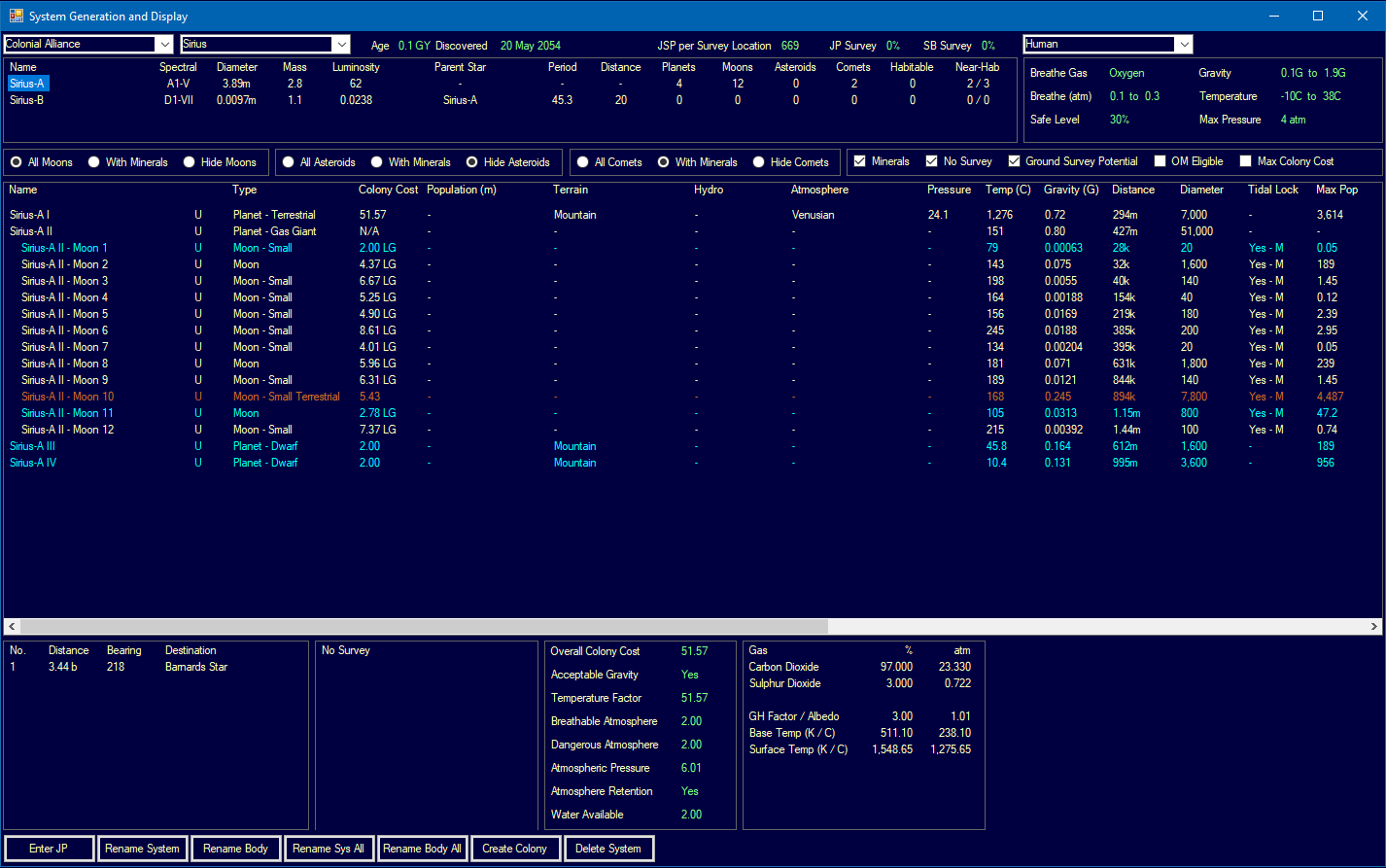 26 May 2054
26 May 2054The European Union completes its research into the ruins on Mars and Russia recovers six maintenance facilities. Ninety-five potential installation remains. The xenoarchaeologists from India and the Colonial Alliance have not yet deciphered the alien language.
7 July 2054India launches Vibhuti, its fourth gravitational survey ship. There is still limited fuel available so Vibhuti and its sister ship Vipul remain in orbit. The two active ships detect the jump point from Lalande to Luyten 205-128, which until this point was only known to China.
15 July 2054China discovers a jump point in Luyten 205-128. Xiangyang moves to investigate. Three nations, the Colonial Alliance, the European Union and the Federative Republic Brazil, have not even completed their survey of Sol, yet China is ready to explore a system three jumps from Sol. Xiangyang transits into an unremarkable system, with the red dwarf star NN 3378 and a single, scorching hot tide-locked planet. The search for a new home for humanity continues. Xiangyang transits back into Luyten 205-128 to resume the gravitational survey with Mianyang.
17 July 2054The European Union launches Altair, sister ship to Antares, and the second European gravitational survey ship.
23 July 2054The other pair of Chinese survey ships is operating in V1216 Sagittarii, located beyond Sol’s second jump point. Yichang detects a jump point one point eight billion kilometres from the primary, the only one detected so far beside the entry point from Sol. Yichang investigates and discovers DX Cancri, a red dwarf system which is now the eighth known system for China, including Sol. DX Cancri has seven planets and over a hundred moons. The second planet is a terrestrial world with a thin nitrogen – oxygen atmosphere, sufficient water locked up its ice sheets and a temperature of -54C. Colony cost is 2.00. Even though the planet is tide-locked, it still has a population capacity of more than four billion due to its 17,000 km diameter. Meanwhile, Russia becomes the third nation to discover Luyten 205-128.
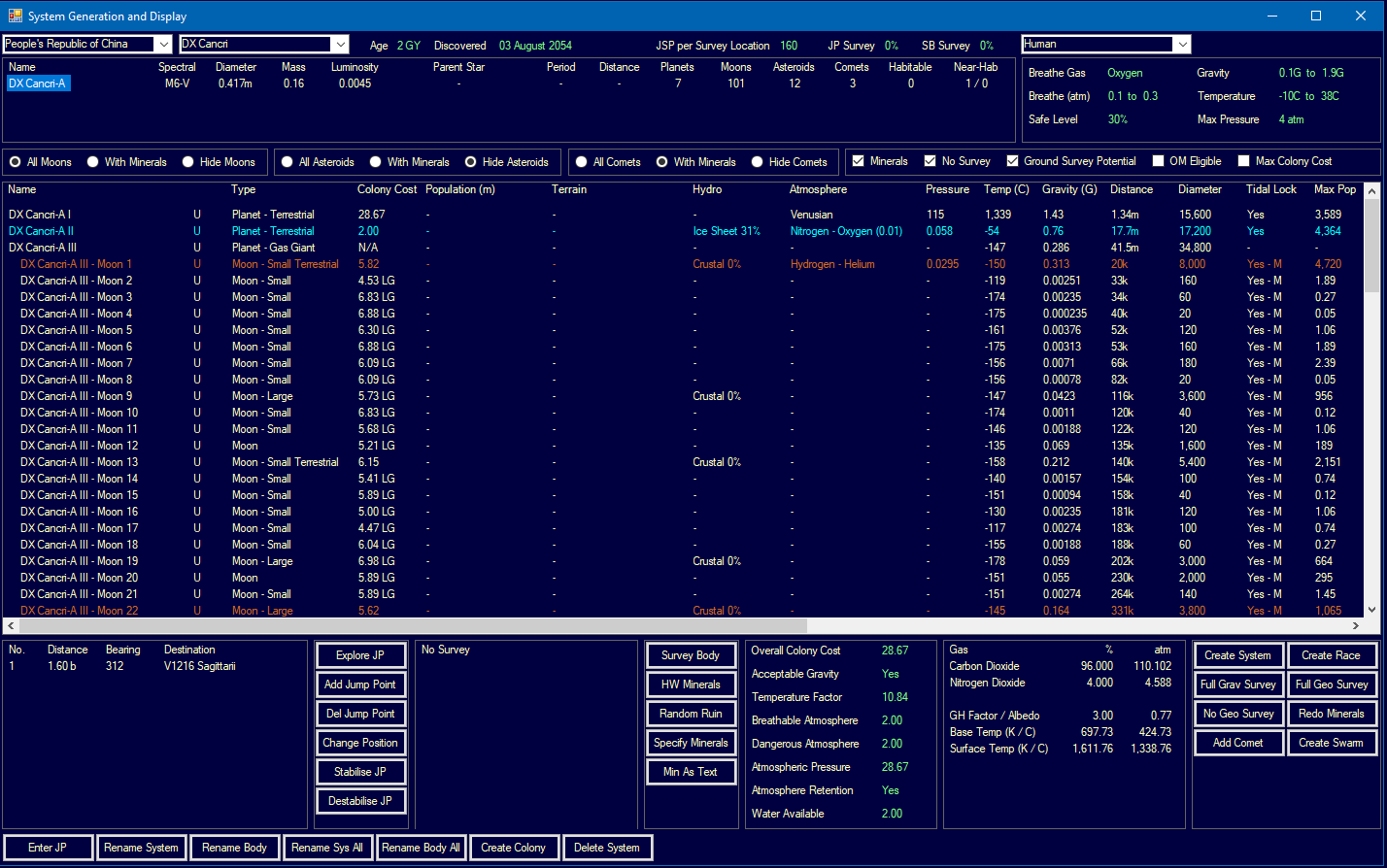 1 August 2054
1 August 2054A second shipping line is created in the Colonial Alliance. Brazil launches its second gravitational survey ship
22 August 2054China completes the survey of V1216 Sagittarii. Sanming and Yichang plus the geosurvey vessel Jinhua all move into DX Cancri to begin new surveys.
26 August 2054The European Union completes its survey of Sol. Antares and Altair head for Alpha Centauri to begin a new survey, the first survey ships of any nation to do so.
14 August 2054Russia builds Neukrotimyy, its third gravitational survey ship. As the two existing Russian ships are surveying Lalande and Bernard’s Star, Neukrotimyy begins a survey of V1216 Sagittarii. For the moment, Russia is looking at all options rather than concentrating on a single route.
20 October 2054A third shipping line is formed in the European Union. Russia launches a fourth gravitational survey ship, bringing it up to the same number as India and China.
1 November 2054All six nations have well-established colonies on Mercury, although the only installations are a Colonial tracking station and a European terraforming installation. China has the largest at eleven point seven million, while Brazil and the Colonial Alliance both have populations in excess of ten million. Europe, India and Russia have colonies of seven, six and four million respectively. Only the Colonial Alliance has extra-solar colonies as all six nations are carrying out a multi-year program of researching new low-power, fuel efficient engines and refitting their existing freighters and colony ships. Fuel continues to be an issue for most nations.
The situation on Earth is relatively good, as the massed terraforming effort firstly reversed the temperature decline and then raised the temperature beyond the original level. The current temperature of Earth is 21C.
8 November 2054China discovers a system three transits from Earth, beyond V1216 Sagittarii and DX Cancri. AX Microscopii is an M0-V red dwarf with six planets, one of which is the most habitable found to date. AX Microscopii III is a terrestrial world with a breathable atmosphere and gravity of 0.81G. The temperature is -113C, but as the planet is tide-locked the temperature effects are significantly reduced, albeit at the cost of far less living space. Unfortunately, the planet is also an Ocean world with 100% water coverage, which combines with the tide-locking makes the population capacity of this Earth-sized world just 27m.
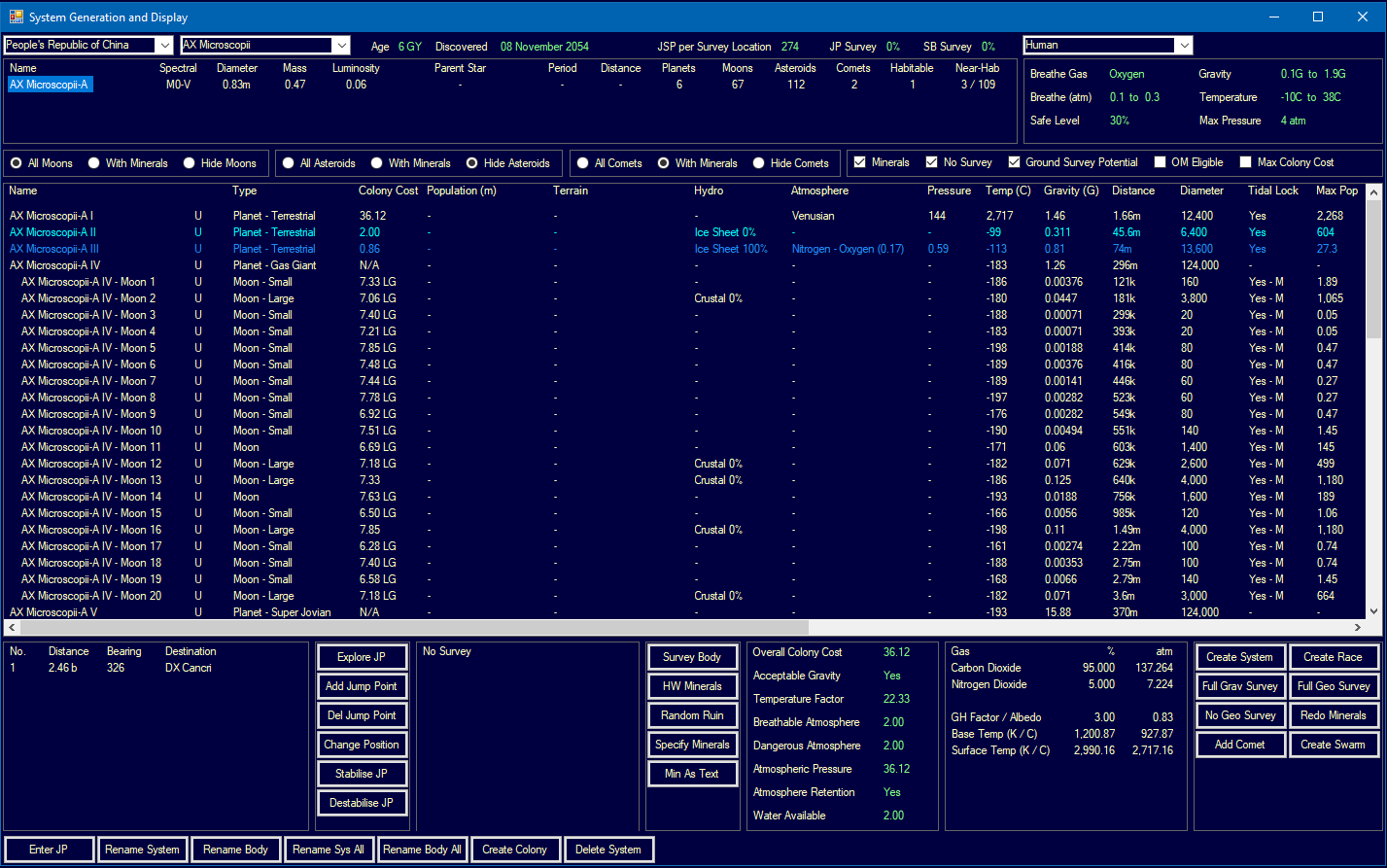
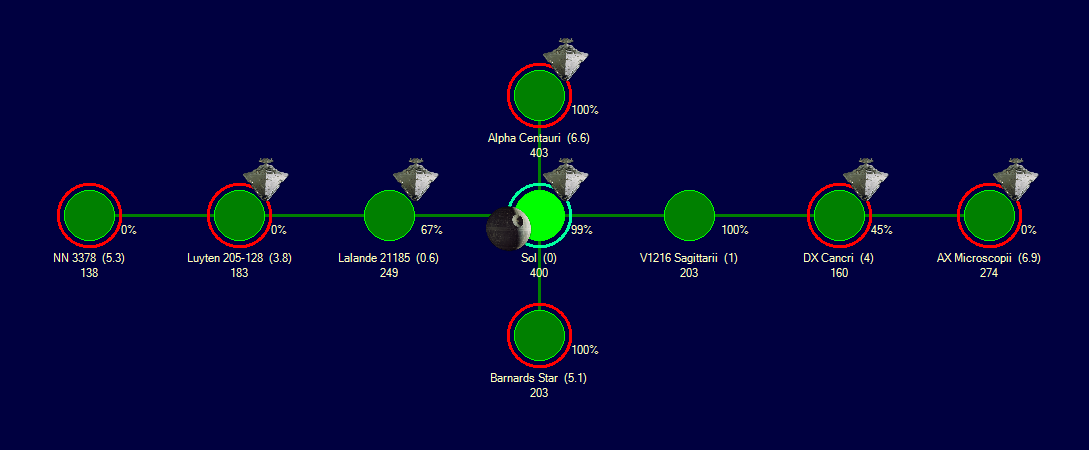 6 December 2054
6 December 2054The Colonial Alliance detects a third jump point in Bernard’s Star. Newton transits and discovers the Procyon system, a binary comprising an F5-IV yellow-white subgiant with three planets and a planetless white dwarf companion. Procyon-A II is an Earth-sized world with liquid oceans covering 64% of the surface, a nitrogen-oxygen atmosphere of 0.79 atm with 0.04 atm of oxygen and a surface temperature of 85C. The world is not tide-locked and has a substantial population capacity of over thirteen billion. Adding 0.06 atm of oxygen and lowering the temperature would turn this planet into an ideal habitable world. This is by far the best prospect so far for the Colonial Alliance.
A new fuel-efficient commercial engine has been designed by Colonial engineers and new colony ship and freighter designs have been developed. Shipyards are being retooled for the new designs. Once the existing ships are converted to the new designs, Procyon-A II will be a colonization target. Newton escorts Galileo into the system to carry out a geological survey then returns to Bernard’s Star to complete the gravitational survey.
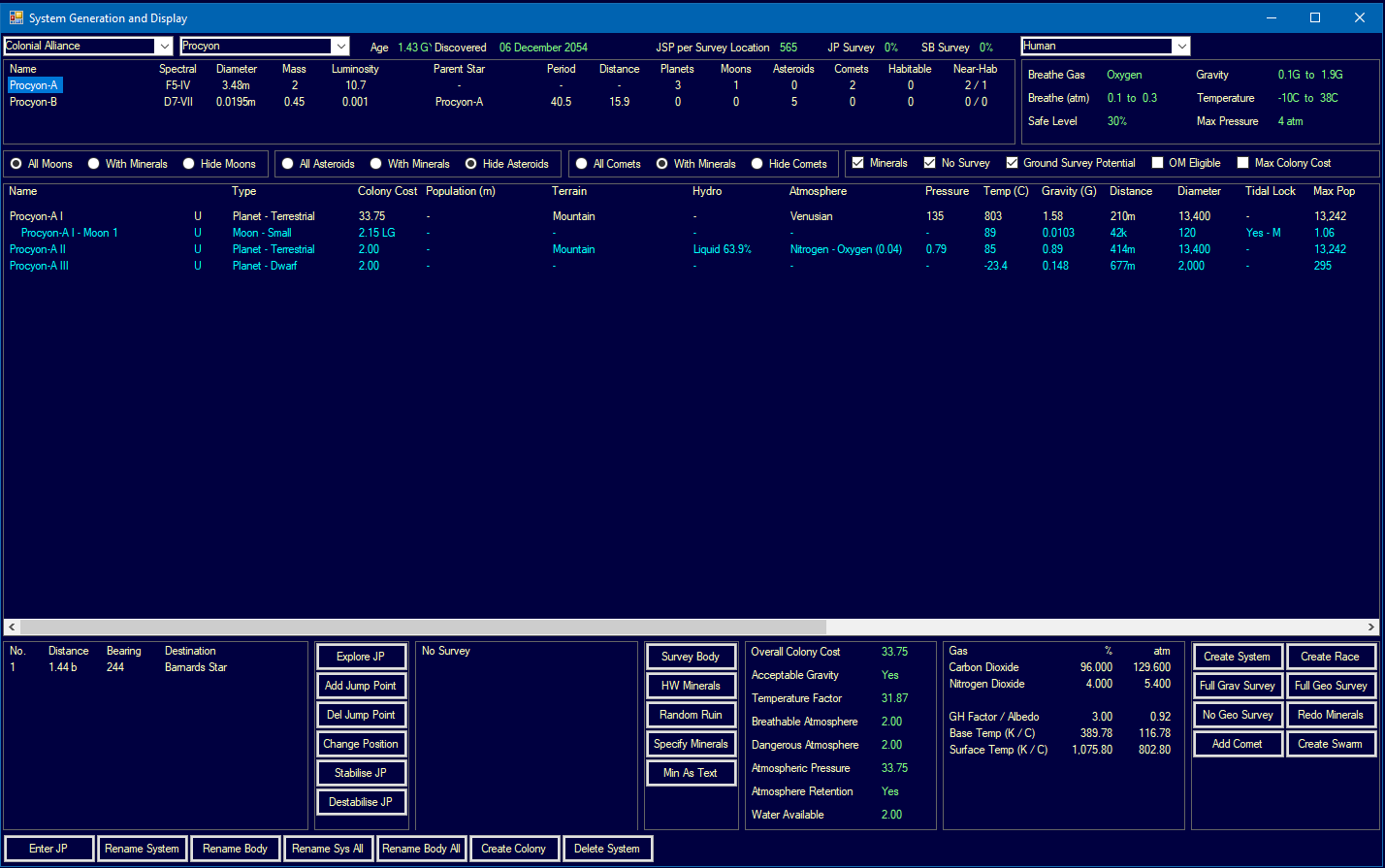
While the People’s Republic has been the most successful nation in terms of locating new systems, there are systems such as Sirius and Procyon that Chinese ships have yet to discover. The situation is becoming complex in terms of which systems are known and surveyed by which nations. A current summary is shown below. Brazil has not conducted a geological survey of the systems surrounding Sol because its jump-capable gravitational survey ships have a jump drive that does not have sufficient capacity for its geological survey ships. Brazil has developed a military jump drive with an 8000-ton capacity, larger than any other nation, which will be deployed on a space station and towed into place by an Albacore class tug, which is currently under construction.
D = Discovered GR = Grav Survey Complete, GE = Geo Survey Complete, Gr = Partial Grav, Ge = Partial Geo
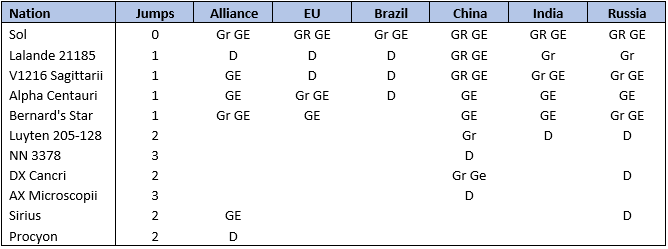 16 December 2054
16 December 2054The European Union discovers a jump point in Alpha Centauri. Antares transits and emerges in Luyten 726-8, a binary system of two red dwarf stars orbiting less than a billion kilometres apart. In total, the compact system has nine planets, eight-four moons and forty-six asteroids. Four of the planets are colony cost 2.00, including two with sufficient surface water, although none have a suitable atmosphere and all are tide-locked. The system does have potential for colonisation though, particularly if It has good mineral resources.
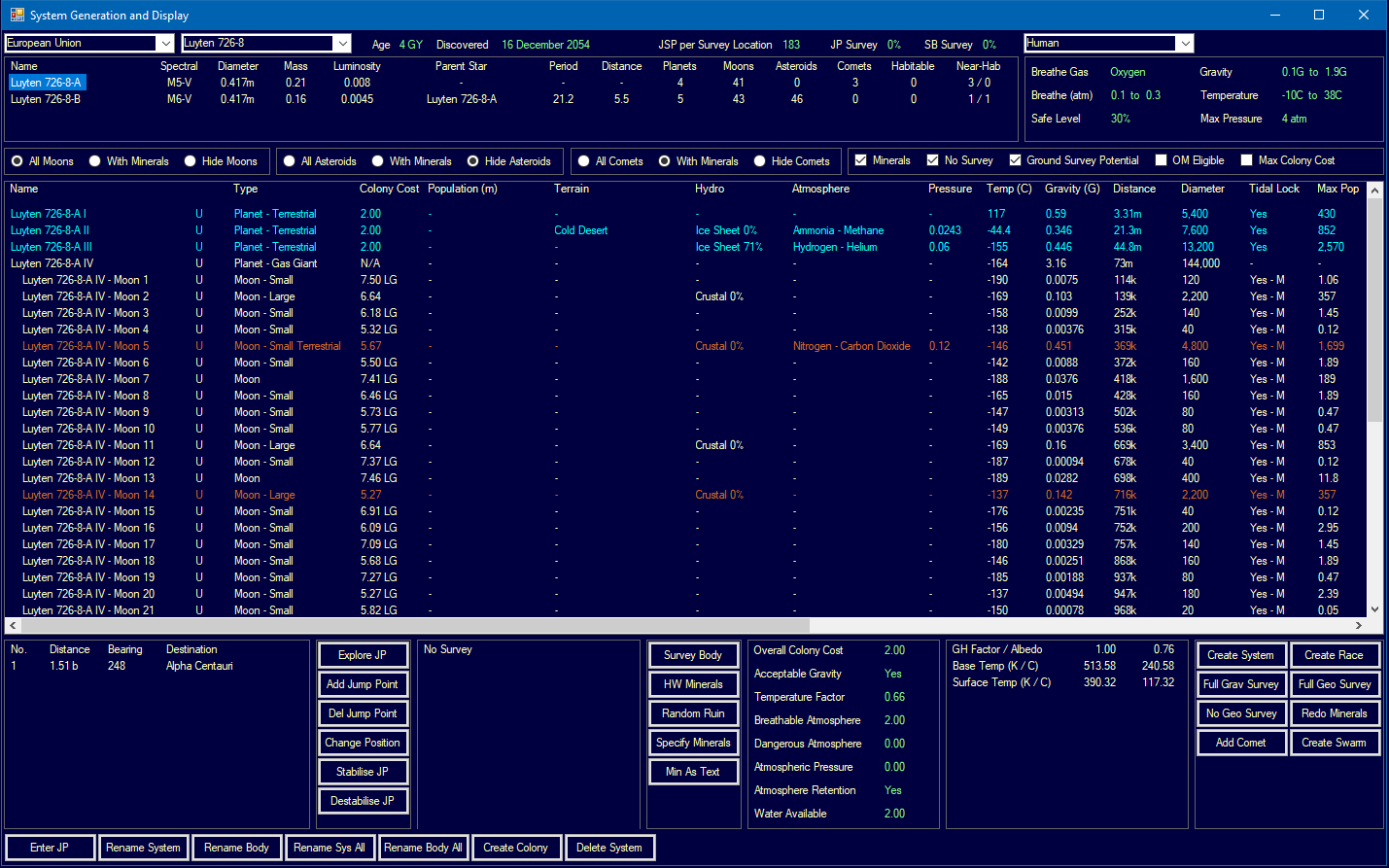
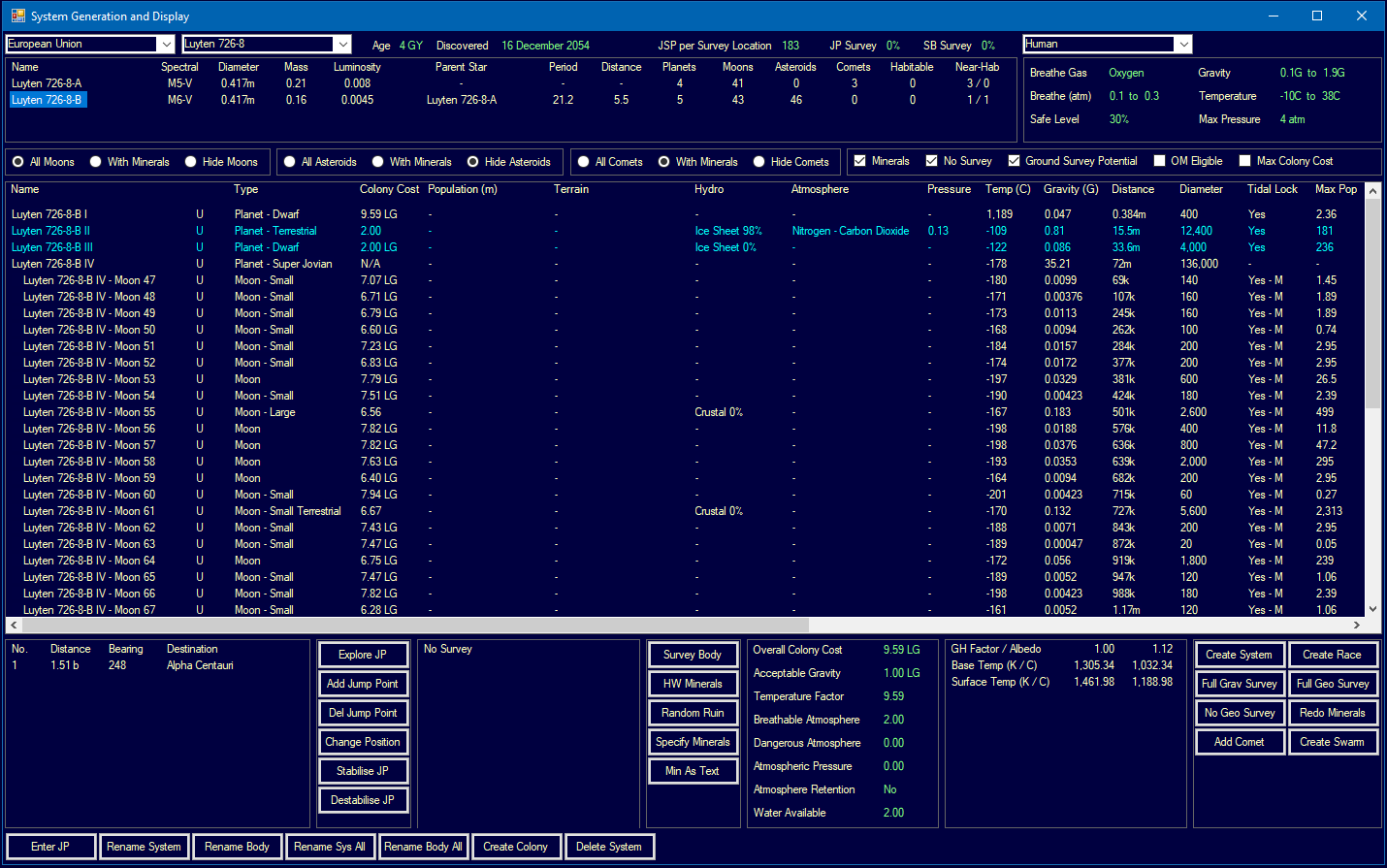 18 December 2054
18 December 2054The Colonial Alliance launches William Herschel, its third gravitational survey ship. Herschel is dispatched to Lalande, beyond Sol’s innermost jump point, to begin a new survey. The second in the class, Carl Sagan, has almost completed the Sol survey and thereafter will join the lead ship Isaac Newton in Bernard’s Star.
24 December 2054Galileo completes a geological survey of Procyon-A II, the Colonial Alliance’s best terraforming prospect. The value of the planet is enhanced considerably by extensive deposits of ten different minerals, including high accessibility deposits of Duranium, Uridium and Corundium. The attractiveness of Procyon-A II as a potential colony site is likely to result in competition from other nations, once it is discovered. As other priorities have been met, the Alliance begun to devote a portion of its research effort to weapons. That weapon research program will now be accelerated.
Procyon-A II Mineral Survey ReportDuranium: 2,908,872 0.90
Neutronium: 23,921,881 0.10
Corbomite: 24,581,764 0.10
Boronide: 26,615,281 0.10
Mercassium: 25,250,625 0.10
Vendarite: 33,977,241 0.10
Sorium: 30,924,721 0.10
Uridium: 10,342,656 0.80
Corundium: 18,386,944 0.90
Gallicite: 30,184,036 0.10
28 December 2054Brazil launches the first Aspirante Nascimento class Jump Tender Station. With an 8000-ton military jump drive, the Aspirante Nascimento will be capable of opening a jump point for all existing Brazilian ships, plus larger vessels yet to be designed. The station will be towed into place by an Albacore class tug, the first of which is under construction.
Aspirante Nascimento class Jump Tender Station 2,850 tons 74 Crew 200.9 BP TCS 57 TH 0 EM 0
1 km/s JR 3-50 No Armour Shields 0-0 HTK 14 Sensors 0/0/0/0 DCR 1 PPV 0
MSP 43 Max Repair 128 MSP
Capitão-de-Corveta Control Rating 1 BRG
Intended Deployment Time: 3 months
MJD-8000 Military Jump Drive Max Ship Size 8000 tons Distance 50k km Squadron Size 3
Fuel Capacity 1,000,000 Litres Range N/A
1 January 2055The alien installations on Mars are being recovered by the Brazil, China, the European Union and Russia. The Colonial Alliance and India have yet to decipher the alien language. Over the last few months, Europe has recovered a research facility, a terraforming installation, three factories, three mines, a mass drive, five point six million litres of fuel and four ECM-1 ship components. Russia has recovered a refuelling station, four mines, a construction factory, three Main Engineering components and seven compressed fuel storage systems. China has recovered a second research facility, five million litres of fuel and ninety low gravity infrastructure. Brazil has recovered a mine and three hundred infrastructure. Sixty abandoned installation remain.
14 January 2055China recovers thirteen meson cannon from the ruins on Mars.
27 January 2055The European Union discovers the system of Struve 2398 beyond a newly discovered jump point in Alpha Centauri. Struve 2398 has a total of twelve planets and one hundred and twenty-nine moons split between a pair of red dwarf stars eight billion kilometres apart. Both stars have LaGrange points, so the distance between them is not an issue. Struve 2398-A I and Struve 2398-B II are both tide-locked terrestrial worlds with sufficient liquid water, nitrogen-oxygen atmosphere with 0.03 and 0.07 atm of oxygen respectively and a colony cost of 2.00. Surface temperatures are 104C and -37C. From the European perspective, these are both potential colony sites two jumps from Earth with access to good mineral resources in Alpha Centauri. Like the Colonial Alliance, the European Union is partway through an upgrade of its commercial shipping with fuel efficient engines.
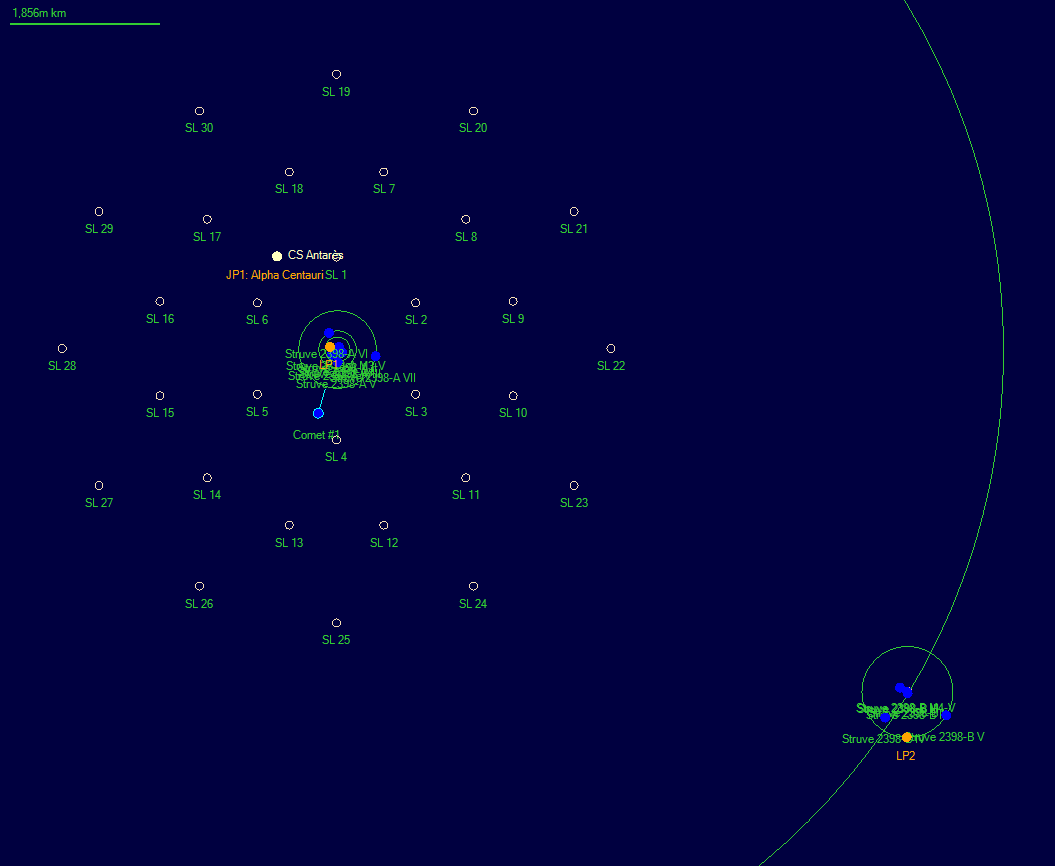
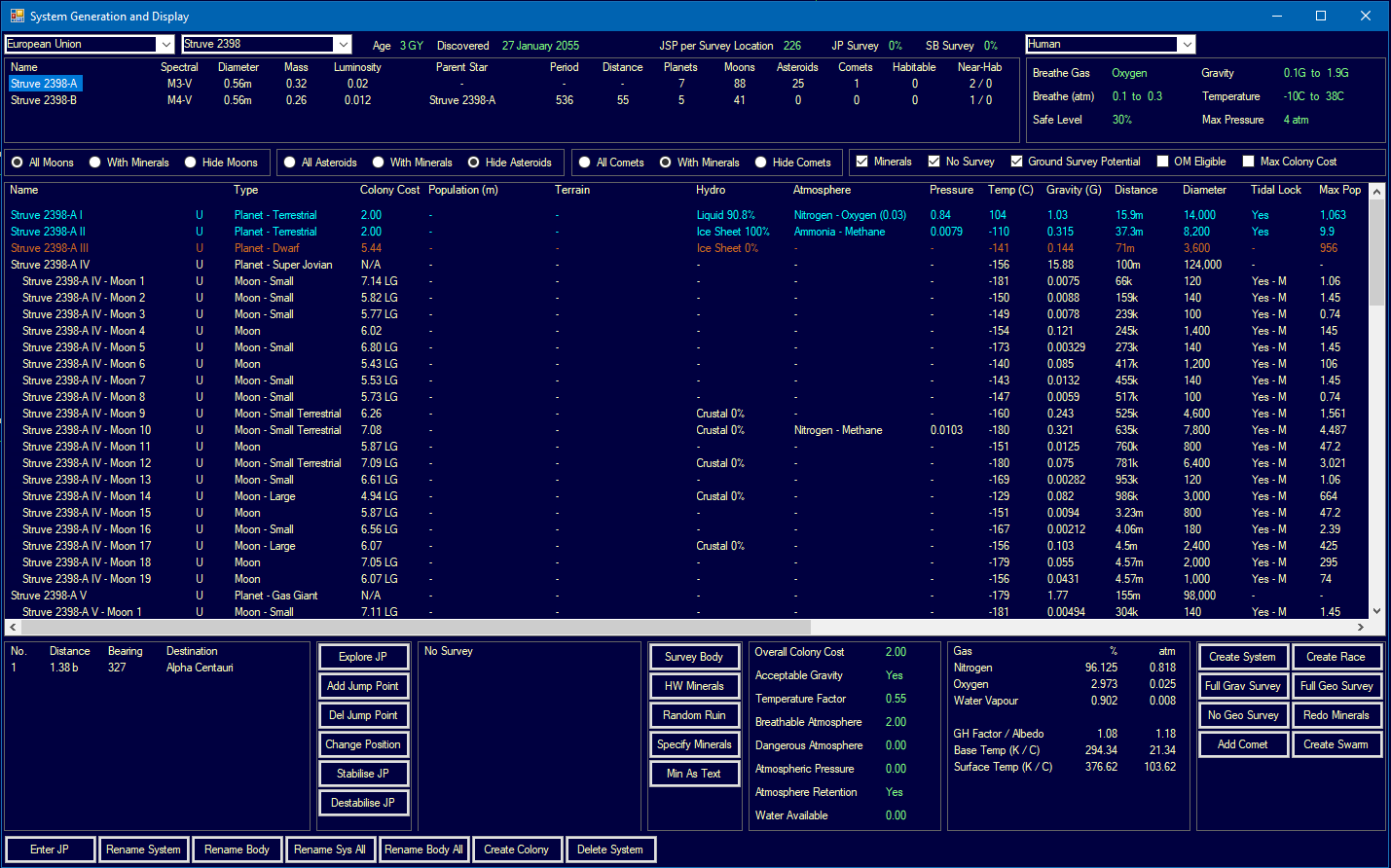
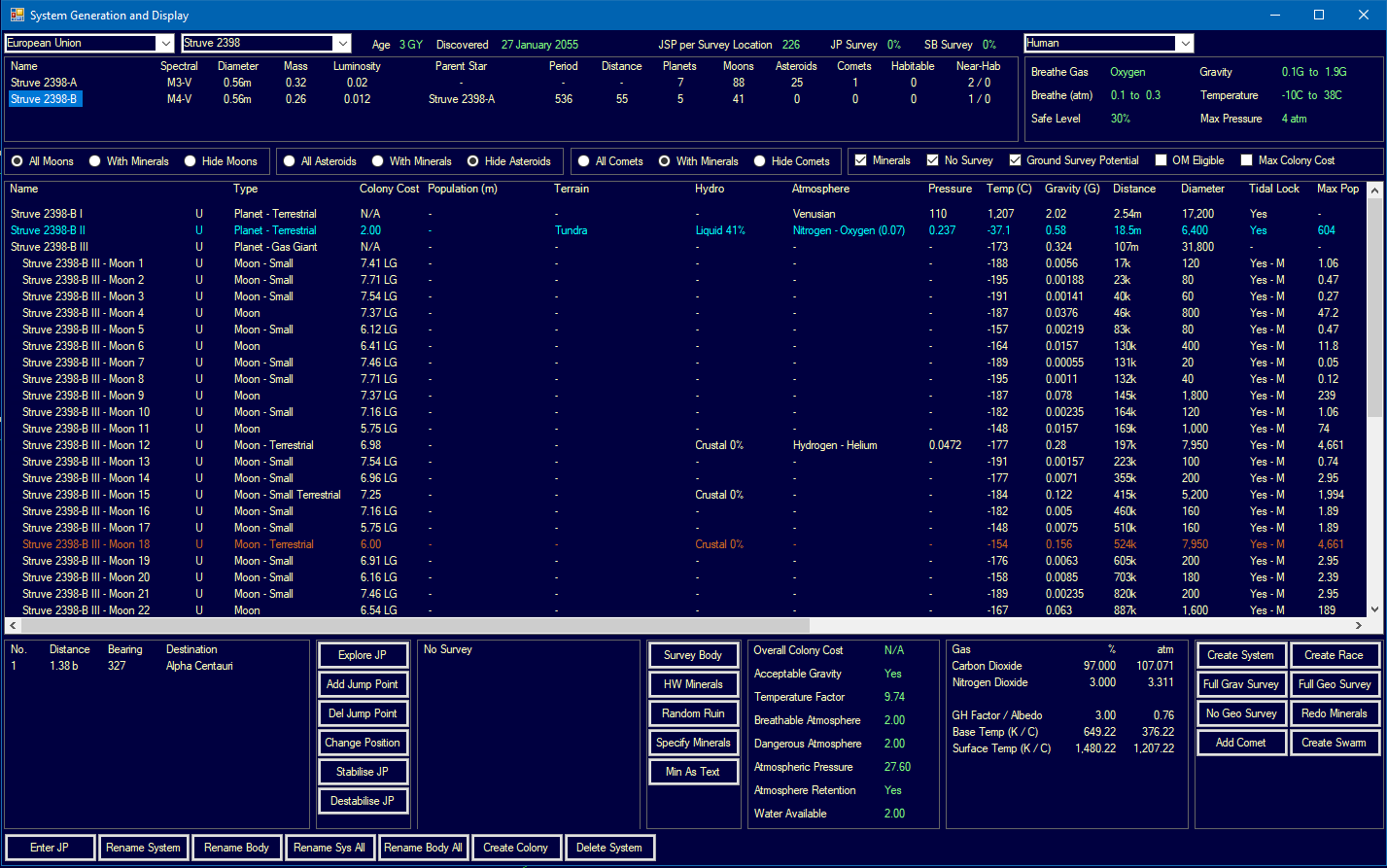 24 March 2055
24 March 2055The People’s Republic of China launches Huludao and Louyang, its fifth and sixth gravitational survey ships. They both set course for the Alpha Centauri jump point